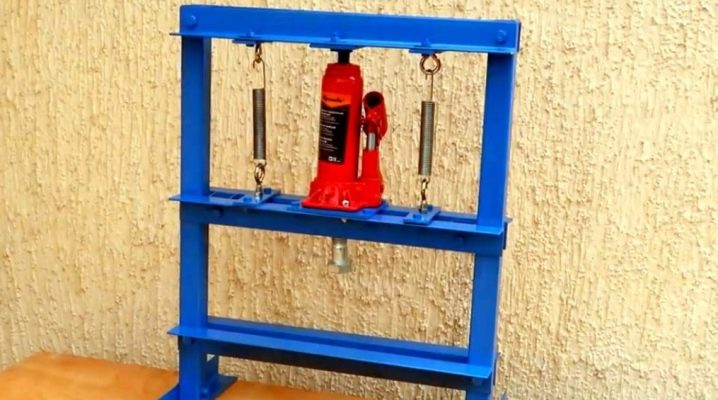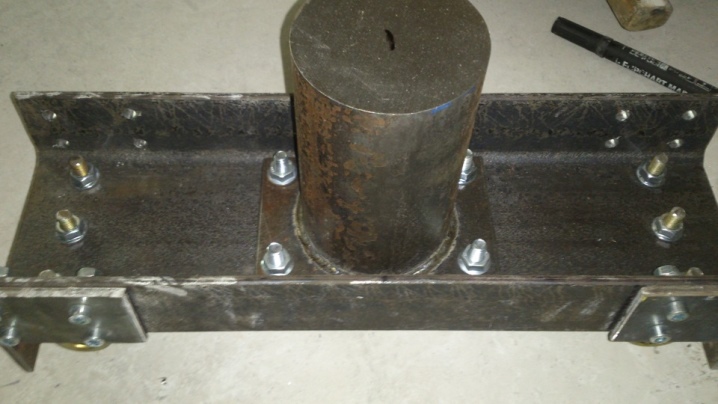How to make a hydraulic press from a jack with your own hands?

A hydraulic press, like a mechanical one, allows without great losses to transfer the force applied by a person or by an electric motor to the workpiece that needs to be flattened... The application of the tool is varied - from straightening strips and sheets of metal to pressing, for example, large areas of glued surfaces that cannot be compressed with ordinary clamps.


Tools and materials
If you come to the conclusion that you definitely need a press - at least a small one - in order, for example, to straighten or crush something flat into a pancake, then the first mechanism that came to mind is This is a hydraulic jack used to raise the chassis of a car to change a wheel, disassemble and replace brake pad parts, get close to the propeller shaft in the field, etc.
Industrial presses, at prices for 2021, start at prices of tens of thousands of rubles: such equipment works with a lot of weight and decent force (pressure) - from 10 atmospheres at a specific point of the compressed planes. A hand press based on a jack allows using a liquid, for example, gear oil or brake oil, to transfer almost without loss the force acting on the workpieces being processed, which require strong compression over their entire area.
A low level of losses is associated with the inability of the liquid to compress - unlike gas, the volume of which decreases up to several times, the liquid will sooner penetrate through a tightly sealed vessel (capsule) than contract by at least 5%. The same effect is used in the braking system of cars.

For the manufacture of a press, in addition to a jack, are required:
- welding inverter and electrodes;
- grinder and cutting, grinding discs;
- hacksaw for steel;
- channel with 8 mm walls - 4 m section;
- square section pipe;
- corner 5 * 5 cm (5 mm steel);
- a strip of steel 1 cm thick;
- a piece of pipe 1.5 cm of a diameter suitable for the jack rod;
- a piece of steel sheet 1 cm thick - with an area of 25 * 10 cm;
- spring of sufficient thickness of the twisted rod (power) to support the press.
Having prepared the necessary materials and tools, proceed with the assembly process itself.



Step-by-step instruction
To make a hydraulic press (for a garage) from a jack with your own hands, do the following.
- Referring to the dimensions in the drawing, mark and cut the workpieces into component parts.


- Secure the parts with clamps before welding - for some of them, rectangular arrangement is extremely important.

- Weld the sections of profiles and pipes to each other, attaching them with side edges and edges... Weld the seams on all sides. Otherwise, the press can burst anywhere - for every square centimeter of the workpiece, it often weighs from tens to hundreds of kilograms. In this case, the rigidity of the structure should be with a two-fold, or better with a three-fold margin, only then the press will serve for a number of years.

- After assembling the press platform, fit the bottom stop and vertical parts. A professional pipe is used for them. The length of the workpieces and the height of the jack standing in place are the same - provided that the rod of the device is raised (extended) to the maximum height. Further margin along the length of the vertical struts is selected according to the thickness of the stop being removed. The bottom support is a piece of a professional pipe that coincides in length with the supporting platform.

- Weld the assembled components into a single whole. Before welding, double-check the squareness of the assembled system - the slightest bevel will immediately lead to a noticeable reduction in the service life of the device. For greater reliability, weld the diagonal spacers - at an angle of 45 degrees at the corners of the frame.

- Next, a detachable stop is placed. He, moving vertically within the guides, clamps the workpieces processed on the press. It is assembled from several steel plates assembled and welded from all four ribs to each other. They should move freely along the guides, while not loosening, not shifting horizontally in different directions. The emphasis itself is bolted to the main part of the jack. The guides themselves are screwed to the same connections - their length is 10 cm longer than the length of the stop.

- Weld a 1.5 cm piece of pipe in the center of the back of the support pad. As a result, this element will be inverted. This trim will fix the jack pin in the center.

- To spontaneously return the jack to its original state (readiness for a new working cycle), install the springs equidistant from the central axis of the rod movement and located opposite each other... They are located between the support platform and the stop. By the moment of the highest effort, at which the workpieces are compressed, the springs will lengthen as much as possible, and when the pressing pressure is removed, the stop will return to its original position.

- After completing the main stage of assembly, install the jack in the press... Move the stop down so that the jack fits in the space provided for it and is ready to work. The end of the jack pin should snap into the cut pipe attached to the bottom surface of the support platform. Secure the jack base with the removable stop using bolted connections.

The press is ready to go.
Remove rust, if any, and paint the device (except the travel rod) with primer enamel.
Additional settings
A homemade press needs a shortened distance that goes back and forth on the travel pin. As a result, the processing of blanks on such a press is much faster. This can be done in three ways.
- A section of a professional pipe is placed on the static stop of the tool - detachable or welded.
- An adjustable lower stop is installed... It attaches to the side struts by bolting at several points.
- Plates of steel are placed on the platform, which act as an anvil... They are also made in the form of a type-setting kit or welded to the site by placing horizontally and grinding off the protrusions accidentally formed during the welding seams.
As a result, you get a press that is tuned for the specific rigid requirements of the stroke of the rod.

Next, watch a video about making a hydraulic press from a jack with your own hands.













The comment was sent successfully.